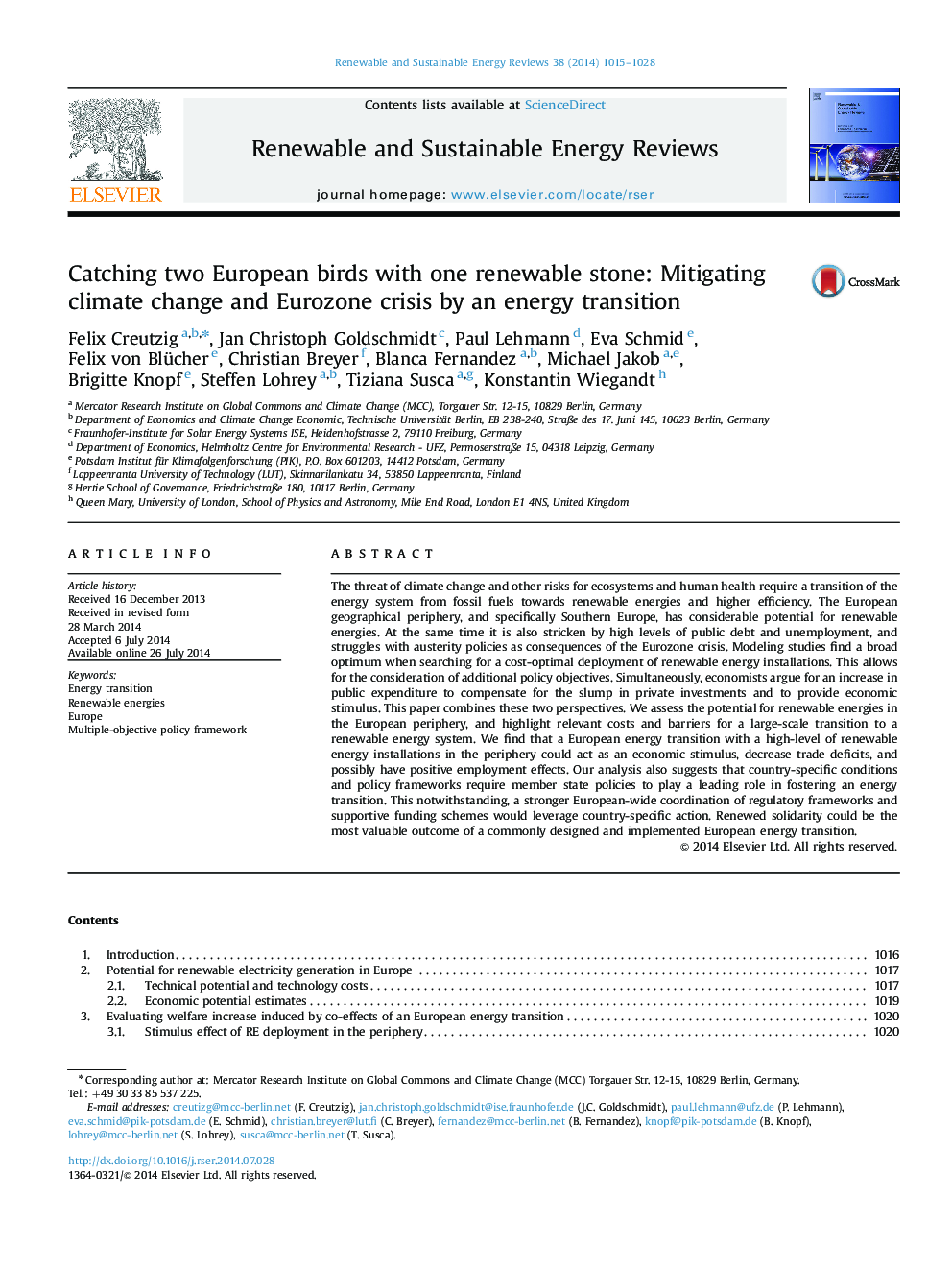| کد مقاله | کد نشریه | سال انتشار | مقاله انگلیسی | نسخه تمام متن |
|---|---|---|---|---|
| 8119889 | 1522347 | 2014 | 14 صفحه PDF | دانلود رایگان |
عنوان انگلیسی مقاله ISI
Catching two European birds with one renewable stone: Mitigating climate change and Eurozone crisis by an energy transition
ترجمه فارسی عنوان
گرفتن دو پرنده اروپایی با یک سنگ تجدید پذیر: مقابله با تغییرات آب و هوایی و بحران منطقه یورو از طریق انتقال انرژی
دانلود مقاله + سفارش ترجمه
دانلود مقاله ISI انگلیسی
رایگان برای ایرانیان
کلمات کلیدی
انتقال انرژی، انرژی های تجدیدپذیر، اروپا، چارچوب سیاست چند هدفه،
ترجمه چکیده
تهدید تغییرات آب و هوایی و خطرات دیگر برای اکوسیستم ها و سلامت انسان نیاز به انتقال سیستم انرژی از سوخت های فسیلی به انرژی های تجدید پذیر و بازدهی بالاتری دارد. پایتخت جغرافیایی اروپا و مخصوصا جنوب اروپا دارای پتانسیل قابل توجهی برای انرژی های تجدید پذیر است. در عین حال، آن نیز با سطوح بالای بدهی های عمومی و بیکاری، و همچنین سیاست های ریاضتی به عنوان پیامدهای بحران منطقه یورو روبرو است. مطالعات مدل سازی در هنگام جستجو برای استقرار هزینه های بهینه از تاسیسات انرژی تجدید پذیر، بهینه ای وسیع پیدا می کنند. این اجازه می دهد تا برای در نظر گرفتن اهداف سیاست اضافی. به طور همزمان، اقتصاددانان برای افزایش هزینه های عمومی برای جبران کمبود سرمایه گذاری های خصوصی و ارائه محرک های اقتصادی ادعا می کنند. این مقاله این دو دیدگاه را ترکیب می کند. ما پتانسیل انرژی های تجدید پذیر در محدوده اروپایی را ارزیابی می کنیم و هزینه های مربوطه و موانع برای انتقال در مقیاس بزرگ به یک سیستم انرژی تجدید پذیر را برجسته می کنیم. ما دریافتیم که یک انتقال انرژی اروپا با یک سطح بالا از تاسیسات انرژی تجدید پذیر در محدوده می تواند به عنوان یک محرک اقتصادی عمل کند، کسری تجاری را کاهش دهد و احتمالا اثرات مثبت اشتغال داشته باشد. تجزیه و تحلیل ما همچنین نشان می دهد که شرایط و چارچوب های سیاست های خاص کشور نیازمند سیاست های دولتی است که نقش مهمی را در پیشبرد انتقال انرژی بازی می کنند. با این وجود، هماهنگی قوی تر در سراسر اروپا از چارچوب های قانونی و طرح های تأمین مالی حمایت می کند که از اقدامات خاص کشور برخوردار است. همبستگی مجدد می تواند نتیجه ی ارزشمند ترین انتقال انرژی اروپائی است که معمولا طراحی شده و اجرا می شود.
موضوعات مرتبط
مهندسی و علوم پایه
مهندسی انرژی
انرژی های تجدید پذیر، توسعه پایدار و محیط زیست
چکیده انگلیسی
The threat of climate change and other risks for ecosystems and human health require a transition of the energy system from fossil fuels towards renewable energies and higher efficiency. The European geographical periphery, and specifically Southern Europe, has considerable potential for renewable energies. At the same time it is also stricken by high levels of public debt and unemployment, and struggles with austerity policies as consequences of the Eurozone crisis. Modeling studies find a broad optimum when searching for a cost-optimal deployment of renewable energy installations. This allows for the consideration of additional policy objectives. Simultaneously, economists argue for an increase in public expenditure to compensate for the slump in private investments and to provide economic stimulus. This paper combines these two perspectives. We assess the potential for renewable energies in the European periphery, and highlight relevant costs and barriers for a large-scale transition to a renewable energy system. We find that a European energy transition with a high-level of renewable energy installations in the periphery could act as an economic stimulus, decrease trade deficits, and possibly have positive employment effects. Our analysis also suggests that country-specific conditions and policy frameworks require member state policies to play a leading role in fostering an energy transition. This notwithstanding, a stronger European-wide coordination of regulatory frameworks and supportive funding schemes would leverage country-specific action. Renewed solidarity could be the most valuable outcome of a commonly designed and implemented European energy transition.
ناشر
Database: Elsevier - ScienceDirect (ساینس دایرکت)
Journal: Renewable and Sustainable Energy Reviews - Volume 38, October 2014, Pages 1015-1028
Journal: Renewable and Sustainable Energy Reviews - Volume 38, October 2014, Pages 1015-1028
نویسندگان
Felix Creutzig, Jan Christoph Goldschmidt, Paul Lehmann, Eva Schmid, Felix von Blücher, Christian Breyer, Blanca Fernandez, Michael Jakob, Brigitte Knopf, Steffen Lohrey, Tiziana Susca, Konstantin Wiegandt,
